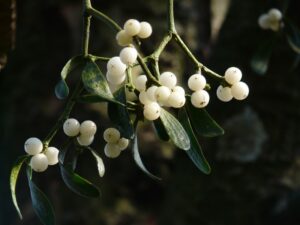Here we are in the month of red and green with indoor trees and outdoor lights! What a special time of year to celebrate the birth of the Messiah with family and friends.
While decorations consist of many different colors and symbols, one of the older yet still most common Christmas adornments is mistletoe. Although live specimens are sometimes expensive and difficult to locate, plastic varieties abound and survive many years in attics with no water or fertilizer.
No one knows for sure how this tradition became connected with Christmas although several possible stories exist. According to early custom, any young lady caught under a sprig of mistletoe was fair game for a young man’s kiss. If she refused his affection, it was thought to bring her bad luck. In more recent years, the privilege of kissing beneath this dangling herb has been extended to either gender and who knows how many supposedly accidental appearances under the mistletoe might really be on purpose!
I remember as a child accompanying my dad and brothers to a tree in the suburbs of Saumsville that had several mistletoe outgrowths on it. I also remember my older brothers climbing high up into that tree to procure some of the prized greenery for our home, although I was careful to avoid its vicinity thereafter as I didn’t want to be kissed.
Mistletoe is actually a parasite that requires a host tree for its survival. There are over 900 species of this unique plant but all require another organism in order to exist. Not one of them can live independently. While parasites usually get a bad rap, scientists now recognize the important role mistletoe plays in its ecosystem by providing food and enhancing diversity.
Depending on the specie, mistletoe plants produce berries ranging in color from white to red which feed birds and other wildlife. These berries contain seeds that land on tree branches after passing through the digestive tract or by being spit out when the bird initially consumes the berry. God coated these seeds with a sticky substance called viscin that cements them to the tree bark until a root like structure sprouts and eventually grows into the host plant.
Once this root pierces the host, a structure known as a haustorium develops which siphons water and other nutrients from its benefactor. Although some mistletoe species can generate their own nourishment through photosynthesis, once they are firmly connected, they become entirely dependent on the tree or bush for their total survival. In some instances they grow so thick that they actually kill part of their host and become the dominant visible greenery. In extreme cases, mistletoe can even kill its host which results in its own demise as well.
This unusual decoration can remind us of the One whose birth we celebrate at Christmas. Much like the host tree or bush, Jesus Himself is our source of true life and He eagerly invites us to colonize Him. His love is the sticky viscin that attracts and attaches us firmly to Himself. After we connect through the haustorium of His Holy Spirit, He happily supplies our water of life as well as all else we need for our spiritual sustenance.
He provides this, however, at enormous personal expense, for His generous grace toward us cost Him not just great injury, but even His own life. Through the miracle of His resurrection, He lives again and enables all who rely upon Him to live as well.
Any joy, vitality, or blessing we enjoy is due to our abiding presence in Jesus, for He assured us, “Apart from Me, you can do nothing.” Although we may exist briefly on earth without Him, we will only survive and thrive eternally if we attach ourselves securely to this life-giving host.
Whenever we notice a sprig of mistletoe hanging in a doorway this season, may it remind us not only of earthly love, but of the love of the One who freely supplies our life and joy. And may we strengthen our connection to Him.
Christmas Blessings, George